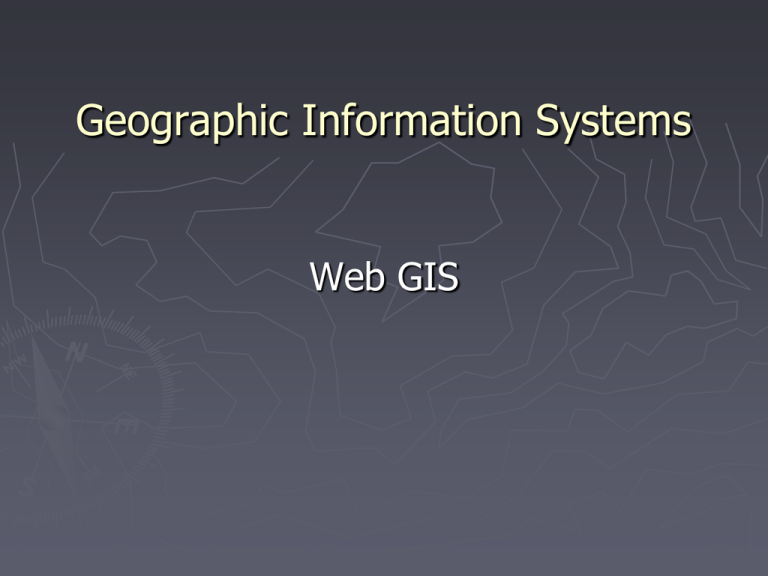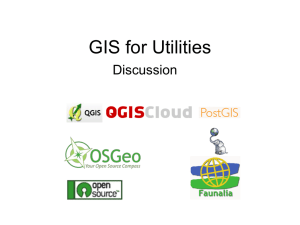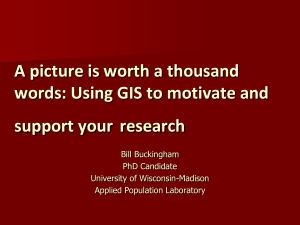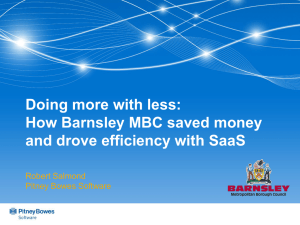Web GIS - Elista
advertisement

Geographic Information Systems Web GIS What is a Web GIS? ► Web GIS is an on-line version of geographic information system ► Using it, GIS data and functions are made available over the Internet ► It is also called Internet GIS, or Online GIS Client-Server network ► A client/server network involves a large number of client computers connecting to a single, central server computer ► Servers usually are high speed computers with robust hardware capacity to handle large volumes of client service requests The Internet Basics of Web-GIS Clients Server(s) Internet or Intranet Optional Separate data storage Data How does Web GIS work? Users (clients) submit requests for maps, data, or analysis to a Web server The server processes the requests and returns requested maps, data, or analysis to the clients Why Web GIS? ► Avoid the complicated (and often expensive) GIS software installation in individual client computers ► Users can access GIS database and GIS applications from anywhere through a common Web browser Three types of architectures ► Thin client architecture ► Medium client architecture ► Thick client architecture Three types of architectures ► Thin client architecture - users only need to display maps ► Medium client architecture - users perform some data manipulation and analysis locally on their own computers, in addition to map display ► Thick client architecture - users perform advanced analysis locally, in addition to map display and simple analysis Three types of architectures Thin client Medium client Thick client Thin client architecture Thin client architecture .. ► Client - Display - requires a standard browser ► Server - Map Render and Element Generator - out of its databases and applications Thin client architecture .. ► Protocol (primarily for data transfer) - e.g. raster data transfer ► Uses - map display ► Examples: - Google Map Medium client architecture Medium client architecture .. Medium client architecture .. ► Client - Display and Map Render - requires a plug-in in the web browser ► Server - Element Generator - out of it’s applications and databases Medium client architecture .. ► Protocol - encoded vector ► Uses - map display, data query, and simple analysis (measure distance, draw a polygon) ► Example: - Google Earth Thick client architecture Thick client architecture .. ► Client - Display, Map Render, Element Generator - requires plug-ins and stand alone tools ► Server - allows for access to its applications and databases Thick client architecture .. ► Protocol - raster, vector, etc. ► Uses - display, data query, and advanced analysis (overlay, buffer) ► Example: - ArcGIS for Server http://www.esri.com/software/arcgis/arcgisserver Applications – Location-based Services (LBS) ► A location-based service - an information service provided by a device that knows where it is ► LBS include services to identify the location of a person, an object, or a place, such as the nearest ATM machine or the whereabouts of a friend LBS-capable device ► ► ► ► Any device that includes a GPS capability, such as a laptop or a smartphone Can tack postal parcels, vehicles, coupons, etc. E-commerce, social networks, mobile networks Web of things, web of people, web of events Required technologies ► Key: determine the location of devices ► LBS requires technologies to work together - Positioning technologies (GPS) Terminal technologies (cell phones) Networking technologies Database technologies (indexes, spatio-temporal DBs) - LBS software (services, base SW) Required technologies .. -… - GIS to Provide and administer base map data such as man made structures (streets, buildings) and terrain (mountains, rivers) Manage point-of-interest data such as location of gas stations, restaurants, nightclubs, etc) LBS for Mobiles Emergency Services E-911 Road-side service Directions Loc-Based Information - Push Reminders Traffic / weather alerts Loc-Based Information - Pull Concierge Shopping City guide LBS for mobiles .. Navigation Directions prior to trip Enroute planning / recommendations Tracking Workforce / Vehicle (fleet/stolen/lost) Family Location-Enhanced Imaging Location info captured with video or sound Send images with maps Location Sharing Friend-finder / landmarks Emergency services ► Provide one of the strongest motivations for LBS ► Problem: users of a cellphone is unable to report his/her current location to enable effective response ► A solution: install GPS in the vehicle www.onstar.com Conclusion - Trends in GIS Potential of Web GIS ► Internet users will be able to access GIS applications from their browsers without purchasing proprietary GIS software ► WebGIS will make it possible to add GIS functionality to a wide range of network-based applications in business, government, and education institutions





